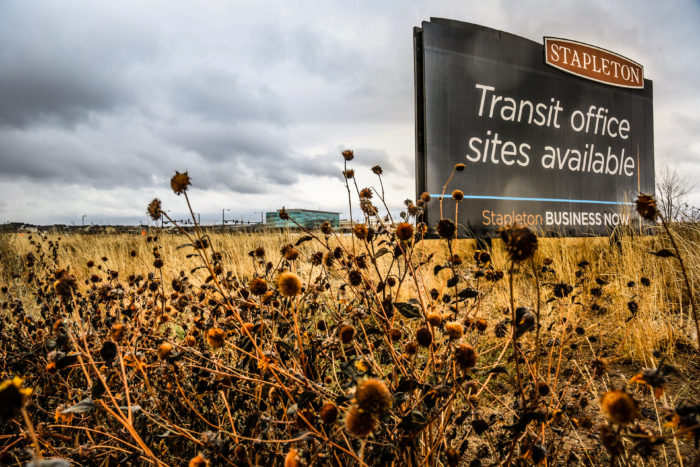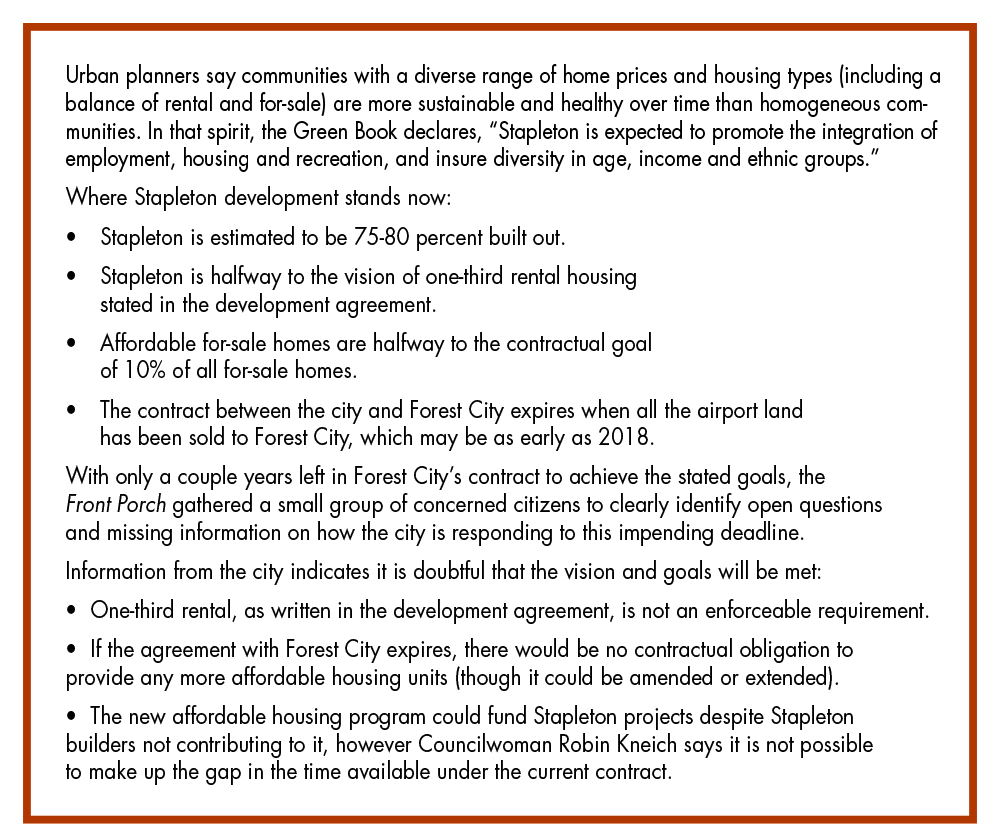
The reservoir of vacant developable land at Stapleton is rapidly declining. It is unknown how many affordable housing units will be located at this site south of Central Park station.

The city of Denver will not require minimum amounts of rental housing at Stapleton. Such housing was expected to be a key element in guaranteeing diversity and sustainability at this city-owned redevelopment site. In response to a question from the Front Porch, Rick Padilla, Denver’s director of housing and neighborhood development, said the development agreement between the city and Forest City “does not require a certain percentage of housing to be rental. While the Stapleton Development Plan (Green Book) is mentioned in the Development Agreement as “principles” to be adhered to, the Development Agreement does not adopt those principles as enforceable terms.”
The development agreement envisioned rental housing to be one-third of housing stock at Stapleton. The Stapleton development agreement does require that 20 percent of whatever rental housing is built be affordable to renters at or below 60 percent of family median income (FMI). However, without a minimum amount of rental housing, the 20 percent affordable requirement has no effect.
Based on figures supplied by Forest City, as of July 31, rental housing makes up 18.6 percent of Stapleton housing. Depending on final build-out numbers, Stapleton is estimated to be 75 to 80 percent built out.
Padilla’s statement about rental housing was included in a written response to several questions presented to the city’s Office of Economic Development. The questions were generated by the Front Porch following a roundtable discussion convened by the newspaper in early November. Participants included three longtime Stapleton residents and activists along with Denver Councilwoman-At-Large Robin Kniech. The group agreed to meet because of growing concern that, as Stapleton approaches build-out, construction of affordable housing is lagging. The group also wanted to explore possible use of Denver’s new affordable housing fund.
For-sale Housing
Denver’s agreement with Forest City does include an enforceable requirement that 10 percent of for-sale housing be available as affordable workforce housing (80 percent or less FMI). Forest City’s second quarter 2016 “Housing Snapshot” indicates such housing is 5.4 percent of for-sale units in Stapleton. Forest City has stated that it will “probably not” meet the 10 percent requirement by project build-out but has promised to set aside the land needed to accommodate the required number of units. The Stapleton Citizens Advisory Board (CAB) has long recommended to the Stapleton Development Corporation (SDC) scenario mapping to ensure that the set-aside parcels can accommodate the required number of units.
Denver’s agreement with Forest City may expire as early as 2018 when all land transfers from the city to the company are expected to be complete. Padilla said, “If the Agreement is not amended or extended and expires in 2018, there would be no contractual obligation to provide any more affordable housing units.” He also said Denver and Forest City “have the legal option to extend or amend the existing Development Agreement prior to expiration” but provided no additional information as to how the existing requirement for affordable for-sale units could be enforced. Previous critiques by CAB members and others have questioned the logic of a development agreement that examines developer performance only at project completion.
Denver’s New Affordable Fund
Another factor bringing Stapleton to a new threshold in terms of affordable housing is Denver’s affordable housing fund that takes effect in January. Revenues to the $15 million fund will be comprised of commercial and residential property taxes as well as a “linkage fee” (development impact fee) imposed on new development. Builders in Stapleton are exempt from the linkage fee because of the city’s development agreement with Forest City. The group convened at the Front Porch roundtable discussed the fund’s usefulness for Stapleton in view of that exemption.
Padilla did confirm the following:
- The linkage fee will apply in Stapleton when the development agreement expires or upon redevelopment of a property in Stapleton, whichever occurs first.
- Despite the linkage fee exemption, projects in Stapleton will be eligible for awards from the fund based on criteria such as location of affordable housing in proximity to high-frequency transit and as an area “at risk of gentrification.”
- The roundtable group discussed the possible use of affordable housing fund monies as a contribution to the “public subsidy” referenced in the Stapleton development agreement. The agreement assumes that a “Public Subsidy will be necessary for Forest City to fulfill the requirements set forth in the Plan.”
Forest City states it has provided some combination of land and/or cash to all the existing affordable housing projects in Stapleton. The Stapleton Citizens Advisory Board has repeatedly requested that information but Forest City has declined to provide it. CAB believes the information is relevant so that a comparison could be made of the Forest City contribution to the amount charged by the linkage fee imposed by Denver’s new affordable housing fund program. Padilla said his office “is not privy to this information.”
Stapleton Development Corporation Role in Meeting the Vision of Affordable Housing
Based on the roundtable discussion, the Front Porch questioned Padilla on the status of a city commitment last year to meet regularly with the SDC to discuss solutions to the gap in affordable housing supply in Stapleton. In response, Padilla said the “OED continues to meet quarterly with Forest City regarding their progress toward affordable housing goals and upcoming production. The most recent meeting was held in September 2016. At previous meetings, the CEO of the Stapleton Development Corporation (SDC) has attended on behalf of both SDC and the Citizens Advisory Board (CAB).
Last December, the SDC chair said an action plan on affordable housing would be presented by the end of the first quarter of 2016. No such plan has been presented publicly.
*Correction from print version of December 2016 Front Porch – Editor’s Note: The article incorrectly stated that the Green Book envisioned rental housing to be one-third of all housing at Stapleton. That proportion is contained in the Stapleton Development Agreement between the city of Denver and Forest City.
Stapleton’s Affordable Housing Plan
- Stapleton Affordable Housing Plan agreed to by Denver and Forest City, January 2001.
- At least 20% of Stapleton rental housing shall be affordable to renters at or below 60% FMI (family median income).
- Affordable housing shall be generally dispersed throughout Stapleton’s 2,935 developable acres, both north and south of I-70. However, the affordable housing should be located near public transportation and shopping areas, and consequently may be more concentrated in certain areas.
- Forest City shall develop or cause to be developed at least 10% of for-sale housing as affordable workforce housing (80% or less FMI).
- SDC (Stapleton Development Corporation) and the city acknowledge that public subsidy will be necessary for Forest City to fulfill the requirements set forth in this plan.
- Forest City shall endeavor to develop or cause to be developed affordable housing units at a pace reasonably consistent with the pace of development of market rate housing at Stapleton.



0 Comments